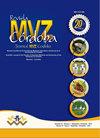阿根廷农村社区猪布鲁氏菌病和钩端螺旋体病的血清流行率和危险因素
IF 0.3
4区 农林科学
Q4 AGRICULTURE, DAIRY & ANIMAL SCIENCE
引用次数: 0
摘要
目标。确定阿根廷布宜诺斯艾利斯省坦迪尔地区农村地区小规模农场饲养的猪中布鲁氏菌病和钩端螺旋体病的血清流行率;分析相关的危险因素;描述流行的钩端螺旋体血清群;并确定这两种疾病的空间分布。材料和方法。共获得340份血清样本。用缓冲板凝集试验、玫瑰孟加拉试验和荧光偏振试验检测布鲁氏菌抗体,用显微镜凝集试验诊断钩端螺旋体病。采用统计学方法评价与感染相关的因素。结果。布鲁氏菌病和钩端螺旋体病血清阳性率分别为0%和22.6%。发现的最常见的钩端螺旋体血清群是Canicola, Ballum, ictero出血和Pomona。与钩端螺旋体病感染相关的主要危险因素是猪数量较多的农场以及农场附近或农场内存在马和野猪。谷物碾磨副产品作为动物饲料的使用和断奶笼的存在也有关联。在低海拔地区发现了钩端螺旋体血清阳性的相关空间聚集群。结论。我们的结果表明,布鲁氏菌病可能得到控制,但钩端螺旋体存在于所研究的养殖系统中。了解布鲁氏菌病和钩端螺旋体病的血清患病率、空间分布和相关风险因素可有助于预防和控制该地区的地方性人畜共患疾病。本文章由计算机程序翻译,如有差异,请以英文原文为准。
Seroprevalence and risk factors for brucellosis and leptospirosis in swine from rural communities of Argentina
Objectives. To determine the seroprevalence of brucellosis and leptospirosis in pigs reared on small-scale farms in rural areas of the district of Tandil, Buenos Aires Province, Argentina; to analyse the associated risk factors; to describe the prevalent Leptospira spp. serogroups; and to determine the spatial distribution of both diseases. Materials and methods. A total of 340 serum samples were obtained. Buffer Plate Agglutination Test, Rose Bengal Test, and Fluorescence Polarisation Assay were used to detect antibodies against Brucella spp. Microscopic Agglutination Test was applied for serological diagnosis of leptospirosis. Statistical methods were used to evaluate the factors associated with the infections. Results. Seroprevalence of 0% and 22.6% was observed for brucellosis and leptospirosis, respectively. The most prevalent Leptospira serogroups identified were Canicola, Ballum, Icterohaemorrhagiae and Pomona. The main risk factors associated with leptospirosis infection were farms with a higher number of pigs and the presence of horses and wild boars near or within the farms. The use of milling by-products of cereal grains as animal feed and the presence of weaning cages were also associated. A relevant spatial cluster of seropositivity to Leptospira spp. was identified in a low-altitude area. Conclusions. Our results suggest that brucellosis is probably controlled, but Leptospira spp. are present in the farming systems under study. Knowledge of brucellosis and leptospirosis seroprevalence, spatial distribution and associated risk factors can be useful for the prevention and control of endemic zoonotic diseases in the region.
求助全文
通过发布文献求助,成功后即可免费获取论文全文。
去求助
来源期刊

Revista Mvz Cordoba
农林科学-奶制品与动物科学
CiteScore
0.70
自引率
0.00%
发文量
41
审稿时长
6-12 weeks
期刊介绍:
The Journal MVZ Córdoba is an open access international scientific journal financed and edited by the University of Córdoba (Colombia). The journal publishes quarterly, continuously in PDF, XML, Epub, original articles, literature reviews, brief communications and clinical cases, peer-reviewed (double-blind) in Spanish and English, which are related to the agricultural and veterinary sciences. The journal is directed to natural and legal persons of veterinary medicine, animal husbandry, public health, epidemiology, aquaculture, biology, basic biomedical sciences and biotechnology and constitutes a space for academic and scientific discussion around the work of professionals in Veterinary Medicine and Zootechnics. Four-monthly publication.
"The Journal MVZ Córdoba supports the policies for registration of clinical trials of the World Health Organization (WHO) and the International Committee of Medical Journal Editors (ICMJE), since it recognizes the importance of these initiatives for international registration and dissemination. of information about clinical studies, in open access. As a result, since 2007, the journal MVZ Córdoba only publishes clinical research articles that have received an identification number in one of the Clinical Trial Registries validated by the criteria established by WHO and ICMJE, whose addresses are available in the ICMJE website. The identification number is recorded at the end of the summary. "
 求助内容:
求助内容: 应助结果提醒方式:
应助结果提醒方式:


